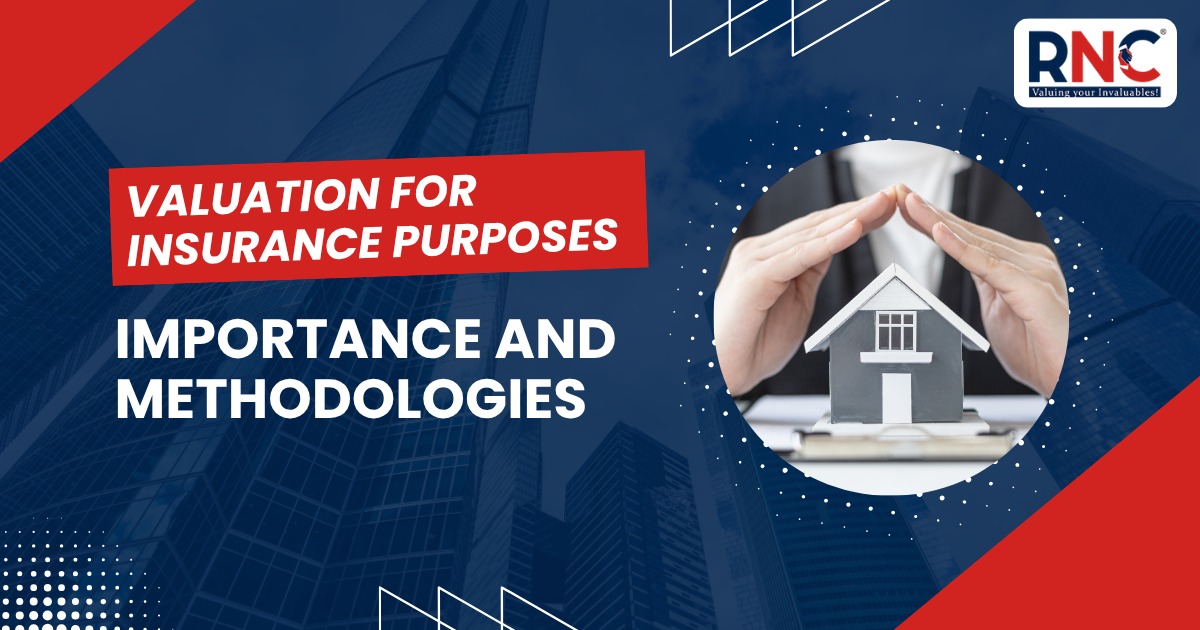
-
Valuation for insurance determines the right sum insured, ensuring assets are neither underinsured nor overinsured.
-
In 2025, insurers demand accurate, defensible valuations aligned with policy wordings, reinstatement conditions, and asset schedules.
-
Key methods include Reinstatement Value (RIV), Depreciated Value, Market Value, and Indemnity Value.
-
Incorrect valuation leads to claim disputes, average clause deductions, and financial loss.
-
Always use a registered valuer to prepare an updated insurance valuation report compliant with insurer expectations.
Insurance valuation ensures that the declared value of your building, plant & machinery, equipment, or inventory reflects their true replacement cost. In 2025, insurers are tightening assessment norms, and incorrect valuations are a major cause of claim rejections and underinsurance penalties.
Valuation for insurance purposes is critical for businesses that want to protect their assets and avoid disputes at the time of claims. Without an accurate valuation, companies risk being underinsured, leading to partial claim settlements, or overinsured, resulting in unnecessary premium payments.
In 2025, insurance regulators such as the IRDA have tightened guidelines to ensure transparency and accuracy in asset valuation. This updated guide explains why insurance valuation is important, explores key methodologies, and shares real-world examples to help businesses safeguard their assets and improve claim outcomes.
Talk to Our Valuation Expertsvaluation for insurance serves as a critical financial safeguard, offering protection when unforeseen events occur. But without knowing the real value of your assets, that net might not hold. Whether you manage a factory, own commercial property, or operate expensive equipment, proper valuation ensures you’re neither overpaying nor under protected.
Looking to close coverage gaps and protect the assets that matter most? Let’s break down how valuation for insurance keeps your business protected—and your peace of mind intact.
Many policyholders assume that the insured value in their policy is accurate—but how is that figure determined? Which valuation methods are typically applied to determine it?
Valuation for insurance purposes determines the correct replacement cost of assets to ensure full coverage and accurate claim settlements. In 2025, it’s mandatory for corporate, industrial, and real-estate assets under regulatory compliance.
Understanding how insurance valuation works can help you avoid claim disputes and secure proper compensation when you need it most.
In this blog, we’ll break down the importance of getting accurate insurance valuations, explore the commonly used valuation methodologies, and explain how these valuations are carried out by professionals. Whether you’re exploring this for the first time or planning to revise your current coverage, this guide will support you in making well-informed decisions.
Ensure compliance and adequate coverage with this ready-to-use checklist covering documentation, IRDA rules, and valuation steps.
Talk to our Valuation ExportsLet’s get into the why, what, and how of insurance valuations—so you can protect your assets confidently and compliantly.
What Is Valuation for Insurance Purposes?
Valuation for insurance purposes refers to the process of determining the correct monetary value of an asset such as a building, machine, or inventory for the purpose of securing adequate insurance coverage. This valuation ensures that in the event of a loss, the insurance payout accurately reflects the asset’s worth based on a standardized method like replacement cost or market value.
Insurance companies rely on valuation reports to assess the level of risk and calculate premiums accordingly. Without a professionally conducted valuation, businesses run the risk of underinsuring or overinsuring their assets, which can lead to claim disputes or financial losses during settlement.
Common scenarios where insurance valuations are necessary include covering commercial properties, manufacturing equipment, plant and machinery, and even stock-in-trade. Whether you’re insuring a factory floor or a fleet of vehicles, having an accurate valuation report gives both the insurer and the insured clarity and confidence.
Why Is Accurate Valuation Important for Insurance?
-
Preventing Over-Insurance and Underinsurance
Accurate valuation ensures you’re not paying extra for coverage you don’t need or falling short when you need it most.
-
Ensuring Accurate Premium Calculation
Insurance premiums are based on asset value—an accurate valuation helps avoid inflated costs or insufficient coverage.
-
Role in Claim Settlement and Risk Mitigation
A clear, professional valuation reduces disputes during claim settlement and supports faster, fairer compensation.
Types of Assets That Require Insurance Valuation
• Commercial Real Estate
Office buildings, warehouses, and retail spaces must be accurately valued to ensure complete coverage for fire, natural disasters, or structural damage.
Learn more : Bank Auction Property in India (2025): Risks, RBI Rules & Buying Process Explained
-
Industrial Machinery and Equipment
Expensive machinery and production units are core to business operations—valuing them helps secure proper insurance against mechanical breakdowns or accidental damage.
-
Inventory and Raw Materials
Stock-in-trade, raw goods, and finished products should be valued regularly to reflect market fluctuations and avoid underinsured losses during transit or storage.
-
Vehicles and Mobile Assets
Company-owned vehicles, forklifts, and other mobile equipment need precise valuation to cover repair or replacement costs in case of accidents or theft.
Common Valuation Methods Used for Insurance
| Method | Description | When to Use |
|---|---|---|
| Replacement Cost Method (RCM) | Estimates cost to replace an existing asset with a new one of similar capacity and technology. | New or modern equipment, plants, or buildings. |
| Reinstatement Value Method (RVM) | Calculates value to rebuild property with identical materials and specs. | Property insurance or fire insurance. |
| Market Value Method (MVM) | Considers current open-market price, adjusting for age, wear, and depreciation. | Vehicles, assets traded in active markets. |
| Indemnity Value Method (IVM) | Replacement cost minus depreciation — represents the actual loss covered by the insurer. | General insurance and machinery breakdown claims. |
Who Can Conduct Valuation for Insurance Purposes?
Getting the valuation done by a qualified professional is critical—not just for accuracy, but also for regulatory compliance and insurer acceptance. Here’s who you should look for:
Certified Valuation Professionals
They are qualified valuers or certified engineers accredited by bodies like IBBI in India or API in Australia. They follow standard practices and formats accepted by insurers.
Chartered Engineers and Surveyors
In many industrial or plant-related cases, chartered engineers prepare valuation reports. Their assessments are often required by insurers for machinery and factory setups.
Industry-Specific Experts
For specialized assets like biomedical equipment, IT infrastructure, or fleet vehicles, it’s best to hire valuation experts with relevant domain knowledge.
Read more : Valuation of Buildings of a Pharma Group Company for Insurance Purpose
Step-by-Step Process of Getting a Valuation Report for Insurance
Getting your assets professionally valued for insurance doesn’t have to be complicated. Here’s how the process typically works:
1. Initial Consultation & Scope Definition
Discuss your asset types, insurance requirements, and coverage goals with a certified valuer. This clarifies the valuation’s objectives and the approach that will be used.
2. On-Site Inspection or Virtual Assessment
The valuer physically inspects the asset or reviews detailed images, specs, and usage data to understand its current condition and functionality.
3. Data Collection & Document Review
Key documents such as purchase invoices, maintenance records, architectural drawings, or inventory logs are reviewed to support valuation accuracy.
4. Valuation Calculation Using Approved Methods
Based on the asset and its use, the expert applies the suitable method—Replacement Cost, Market Value, or Actual Cash Value—to determine insurable worth.
5. Final Report Preparation & Issuance
A comprehensive report is generated, including asset details, methodology used, photographs, and insurable value, formatted as per insurer guidelines.
6. Review with Insurance Provider
Provide the valuation report to your insurer to confirm it matches your policy coverage. This may help in adjusting premiums and ensuring proper coverage.
Read More : Property Valuation for Insurance: Tips for Homebuyers and Homeowners
Case Study: Accurate Valuation Prevented a ₹1.5 Crore Claim Shortfall
A manufacturing client insured machinery at book value ₹8 crore. Post-fire, replacement value was ₹9.5 crore, leaving a ₹1.5 crore under-insurance gap.
After reassessment using
RNC’s certified valuation
the client updated coverage and secured full claim payout in the next policy term.
Conclusion – Why Expert Insurance Valuation Matters
An accurate valuation for insurance purposes is not just a formality—it’s a financial safeguard. It ensures that your commercial property, equipment, or inventory is insured at its true value, helping you avoid both overpayment on premiums and unpleasant surprises during claims.
Accurate valuation for insurance is the foundation of effective risk management. It not only ensures compliance with IRDA regulations but also prevents disputes and financial losses during claim settlements. As recent 2025 claim disputes have shown, businesses with updated and professional valuation reports enjoy smoother claim processes and better financial security.
👉 Need help with insurance valuation of assets?
At RNC Valuecon LLP, our experts provide precise, IRDA-compliant valuation reports for plant & machinery, buildings, and business assets.
📅 Book Your Insurance Valuation today and ensure your coverage matches the true worth of your assets.
Frequently Asked Questions (FAQs)
1. Why is valuation important for insurance?
To ensure the sum insured reflects the true cost of reinstating assets.
2. What happens if my assets are underinsured?
Claims get proportionately reduced under the Average Clause.
3. Who should perform insurance valuation?
A registered valuer with experience in buildings, plant & machinery, or assets.
4. How often should valuation be updated?
At least annually or whenever asset values change significantly.

About the author:
Sahil Narula
Sahil Narula is the Managing Partner at RNC Valuecon LLP and a Registered Valuer with IBBI. He brings over a decade of experience in Valuation Services, Corporate Finance, and Advisory, having led numerous complex assignments under the Insolvency & Bankruptcy Code, 2016, Mergers & Acquisitions, Insurance, and Financial Reporting.
He is a regular speaker at national forums (ASSOCHAM, CII, ICAI, IBBI, Legal Era) and currently serves as Co-Chairman of ASSOCHAM’s National Council on Insolvency & Valuations and a member of CII’s Task Force on Insolvency & Bankruptcy.
🤝Connect with Sahil on LinkedIn.
